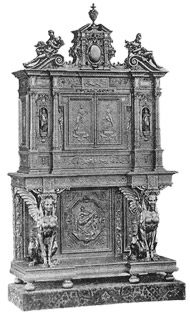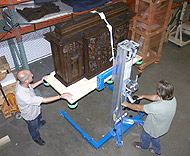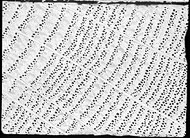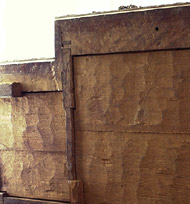 |

 |
 |
Cabinet, French, about 1580 with late-19th-century additions
|
 |
As recently as five years ago, most people believed this cabinet was a 19th-century piece purporting to be a 16th-century cabinet—in other words, a fake.
When scholars reexamined it in 2001, they came to a very different conclusion. They now believe that the cabinet was made in 1580 and is one of the rarest and most valuable cabinets from the French Renaissance in the United States.
This exhibition tells the story of this discovery, offering a case study in how we learn about art.
|
 |

 |
 |
Renaissance Revival cabinet, 1800s
|
 |
 |
|
|
 |
J. Paul Getty bought the cabinet shown above in 1971 against the advice of his curators, who did not think it was genuine.
The cabinet was in suspiciously pristine condition and the surface was coated with colored wax, suggesting that someone had tried to make it look older than it really was. Experts concluded that the cabinet was a product of the Renaissance Revival of the 19th century, when American industrial magnates snapped up Renaissance-style furniture, including many fakes, from cash-strapped European aristocrats.
The cabinet at left, for example, was made in the 19th century in the Renaissance Revival style.
Getty paid $1,700 for the cabinet shown at the top of this page, a far cry from the asking price of $46,640 some 50 years before. The dubious cabinet was never displayed in the Getty Museum—until now.
|
 |
 |

 |
 |
Preparators move the Getty cabinet out of storage
|
 |
In 2001, curators in France organized an exhibition on 16th-century cabinetmaker Hugues Sambin. After a Getty curator visited Écouen to meet with scholars there, she decided to launch a thorough reexamination of the Museum's cabinet.
Curators, conservators, and scientists teamed up to conduct research and scientific analysis. Science can help authenticate an object by dating the materials from which it was made.
|
 |

 |
 |
Close-up photograph of tree rings from the cabinet's oak panels
|
 |
 |
The team's first scientific tool was dendrochronology, or tree-ring dating. Using this method, they discovered that the oak tree used to make the cabinet's structural panels was harvested in late 1574 or early 1575 in Burgundy, a region in southeastern France.
Factoring in the time needed to dry the wood and construct the cabinet, this result coincides with the date of 1580 painted on the cabinet.
  How does dendrochronology work? How does dendrochronology work?
|
 |
 |

 |
 |
Conservator Arlen Heginbotham drills a small hole to collect sawdust for analysis
|
 |
Scientists then used carbon dating to date the surface wood of the cabinet. It is walnut, a wood with an irregular growth pattern that cannot be dated using dendochronology.
Scientists took tiny samples from the walnut and from the frayed edges of the silk and linen lining in the middle drawer. All the samples dated to between 1400 and 1600.
  How does carbon dating work? How does carbon dating work?
|
 |

 |
 |
A 16th-century plane left these distinctive marks on the cabinet's rear panels
|
 |
 |
The team also used another tool: their eyes.
They examined the marks left on the wood by woodworking tools, which can help to date a piece of furniture.
The rough marks on the back of the cabinet, for example, were made by a hand-held saw and a type of plane used in the 16th century. The walnut and oak parts of the cabinet also have identical marks from a "bench dog," a toothed iron clip used to secure wood to a workbench. This suggests that both woods were worked on the same bench at roughly the same time.
Under a layer of red velvet fabric in the cabinet, the team found old nail holes from an earlier lining. These holes held traces of the original 16th-century fabric that still lines the drawer. Analysis of the tacks and tack holes on the door of the cabinet provided further proof of authenticity.
|
 |
 |

 |
 |
After-death household inventory of Fernand Gauthiot, lord of d'Ancier, Besançon, taken between April 1 and May 12, 1596
|
 |
 |
|
The team delved into archival sources to learn more about the source of the cabinet.
Curators located a 1596 household inventory, pictured here, that describes two French Renaissance cabinets. One of the cabinets is now in the Museum of Time in Besançon, France, and has been definitively dated to 1581. The other cabinet may be the Getty cabinet.
The paintings and carvings on the two cabinets were closely examined by curators. Minute clues and subtle coincidences of style indicated that the cabinets may well have been made by the same artist or group of artists.
Who was this person or persons? Curators, conservators, and scientists continue to work on this mystery.
  Compare the Getty cabinet with the Besançon cabinet. Compare the Getty cabinet with the Besançon cabinet.
The exhibition is located at the Getty Center, Museum, South Pavilion.
|
 |







